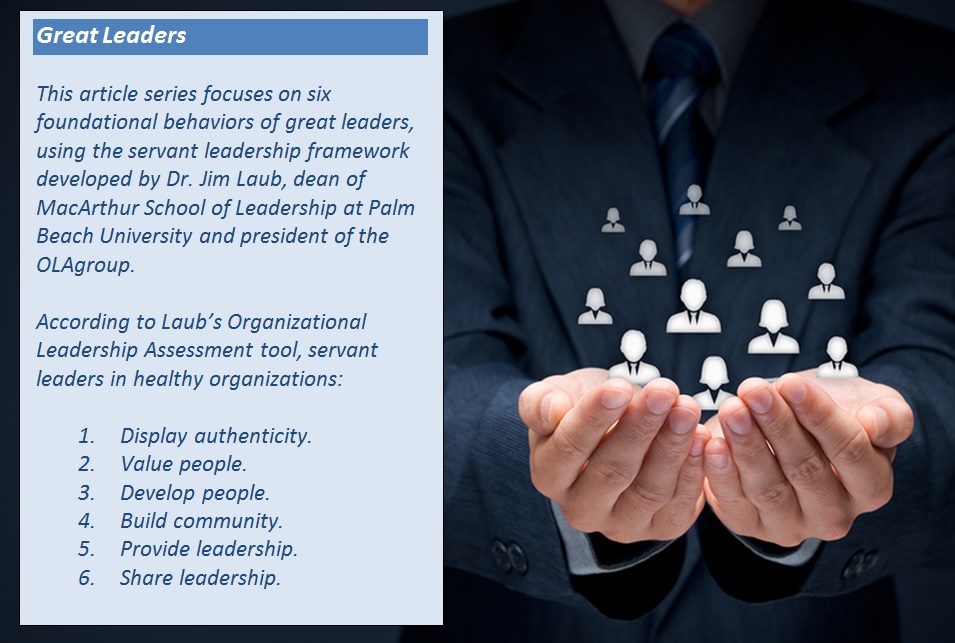Building community within an organization encompasses many activities, but here are three basic practices of great leaders.
Executive Summary
Executive Coach Marcel Schwantes continues his series of articles on the traits of great leaders. Building on the ideas presented in this series so far, and using Dr. Jim Laub’s servant leadership framework for gauging organizational health, he focuses on the fourth thing that great leaders do differently: They build community.In Part 1, Schwantes discussed how great leaders display authenticity.
In Part 2, he outlined how great leaders value their people.
In Part 3, he described how great leaders develop their people.
- They develop strong personal relationships.
This means spending time with your people, and not for your own personal gain. This is about investing time with your most valued employees and managers to learn who they really are.
But don’t just get together over a latte to share hobby stories. The focus should be to deepen relatedness—by sharing information about yourself and the organization (transparency), showing that you care about them (empathy), and discussing your intentions openly.
The phrase “I must know you to grow you” rings true here. So get to know about their strengths, find out where their passions are, their gifts and how to apply them. You’ll be surprised at how much more talent you may have under the roof that will benefit the company in new ways. Your marketing director may be a closet blogger with brilliant contributions to further your brand promise.
- They work collaboratively with others.
Great leaders work together with others more than on their own—collaborating alongside their tribe members instead of separate from them. And they replicate that environment for other leaders to practice.
The best example of this comes from Richard Sheridan, CEO and chief storyteller of Menlo Innovations and author of “Joy, Inc.” In a recent podcast interview, he shares about how his “office” is really just a five-foot table strategically located in the middle of the room—an open-plan workplace. Yes, this is the CEO of one of the most innovative and productive software development firms in the country. No condo-size office with floor-to-ceiling windows with the best view in town—instead, he is right in the middle of the action.
Sheridan says that “the team has full economy over the physical space…They can choose the space however they choose” according to how it will be most helpful to them in collaborating on a project.
At Menlo, sharing is caring. Programmers work in twos (sharing one computer) to allow for creativity as well as enthusiasm. Tandems stick together for five days and then shift into new tandems on new projects.
Because Sheridan cares less about status, position, rank and level, and more about innovation, creativity, culture and collaboration, Menlo has been named a top place to work for several years running.
- They value and operate with diversity.
Great leaders celebrate differences and gain the strength that comes from differences in culture, race, ethnicity, personality type, gender, and individuality of style and expression.
They do this with one aim in mind: to build a healthy and productive work community where there is a steady flow and diversity of ideas and fresh perspectives that lead to results. Otherwise, what’s the point?
They hold themselves accountable to make sure this is happening. For example, they will measure demographics in their talent pipeline of incoming talent as well as existing talent for promoting people equitably. They will measure upward movement throughout management at each tier level all the way up to the C-suite. This helps to safeguard against the “boys club” or nepotism. They will have diversity councils in place to ensure diversity.
In closing, the biggest point I want to make today is that there is immense power in building healthy communities at work and connecting to people on a relational, authentic level. Why? Because relationships drive human satisfaction and performance. We are wired for it. When leaders pave the way, collaboration, productivity, trust and morale will reach new heights.
(Next article in this series: How Great Leaders Lead)























 How Insurers Can Avoid Post-Merger Technology Failure
How Insurers Can Avoid Post-Merger Technology Failure  Carrier Management’s 2025 Top Features (Reader’s Picks Unlocked)
Carrier Management’s 2025 Top Features (Reader’s Picks Unlocked)  Nearly Half of 100 Largest P/C Insurers Destroy Value: ACORD
Nearly Half of 100 Largest P/C Insurers Destroy Value: ACORD  Good Times for U.S. P/C Insurers May Not Last; Auto Challenges Ahead
Good Times for U.S. P/C Insurers May Not Last; Auto Challenges Ahead 









